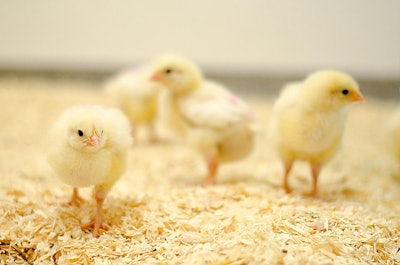
Researchers have developed a simple, low-cost approach that monitors chick welfare using an automated listening system.
The study, conducted by a collaborative team of scientists from the University of Plymouth, University of Roehampton, Scotland’s Rural College and Newcastle University, collected and analyzed acoustic recordings of more than 25,000 chicks across 12 flocks.
"On their first day in a barn, all chicks are going to call because they are in strange surroundings. But after that they learn where to find food and water and settle into that new world, so if you are still hearing a lot of distress calling after a few days it could be a sign there is something wrong,” said lead author, Dr. Katherine Herborn, Lecturer in Physiology and Behaviour at the University of Plymouth.
“With over 50 billion birds being produced each year, tools to support simple interventions at the right time could potentially have big impacts on welfare and quality of life for these birds.”
‘Spectral entropy’
The new method measures the ‘spectral entropy’ of the soundscape, meaning it analyzes changes in tonal sound. Put simply, the system listens for deviations from expected background sound. This kind of automated acoustic monitoring system can reliably distinguish distress calls from the chicks from other facility noises, such as regular calling or farm machinery.
Today, many farms rely on manual observation and subjective scoring methods to assess broiler welfare. Automated approaches remove any chance of manual error and could enhance bird welfare and improve efficiencies for producers.
Chick cries could predict long-term welfare
Interestingly, the research revealed that distress calling could be an indicator of more than just current stress or anxiety-like states in the chicks. The cries could also be used to predict flock-level behavior, future growth, mortality rate and a range of other welfare information about the birds.
"By analyzing the calls chicks make in their first few days of life, it seems we are able to predict weight gained and the number of deaths in the whole flock for the whole life. This means we could have a very powerful tool to help chicken welfare,” Lucy Asher, Professor in Animal Behaviour Informatics at Newcastle University and Principal Investigator, added.
“What is particularly useful is that this welfare indicator can be used early on in life, whereas most chicken welfare indicators are taken later in their life when it is too late to make major improvements. As an added benefit this study shows how we can measure chick calls automatically, meaning no extra work for farmers, but more information to help them improve chicken welfare."
The study was published in the Journal of the Royal Society Interface and was funded by the Biotechnology and Biological Sciences Research Council in an Innovate UK partnership with Greengage Lighting Ltd.
Like what you just read? Sign up now for free to receive the Poultry Future Newsletter.


















